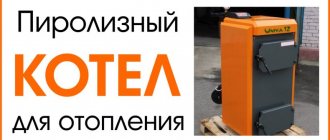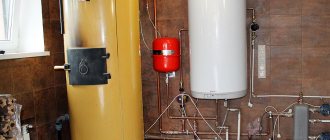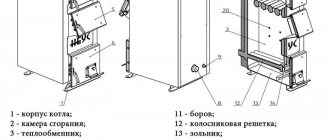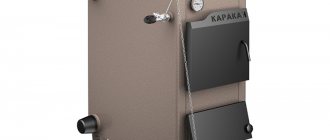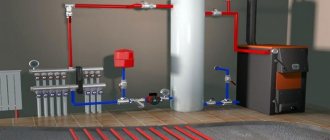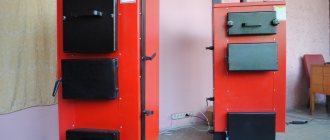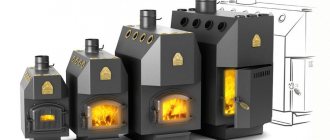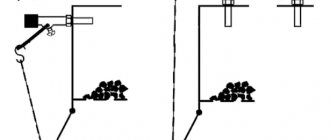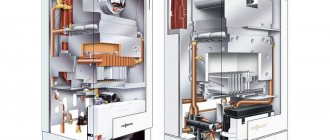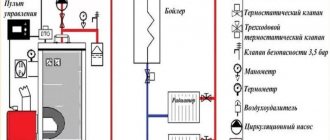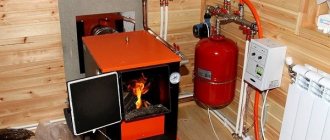The most effective way to use wood fuel is wood-fired gas generator boilers.
Gas fired wood fired boiler
Depending on the modification or manufacturer, the efficiency of such installations can reach 95 percent. In such devices, wood fuel burns almost completely, leaving no residue.
Gas-generating boilers were once used even to drive cars, but now they firmly occupy the traditional niche for boilers - they are used for heating rooms and heating water. What is the operating principle of a gas generator boiler, and how to choose a gas generator boiler when purchasing?
How and with what to heat the boiler
Any solid fuel releases carbon monoxide in a certain amount during combustion.
There is especially a lot of it when wood burns. That is why it is wiser to add firewood rather than any other fuel to a gas generator boiler designed to create a comfortable temperature in the house.
In order for the premises to be heated well, the gas generator boiler must be used correctly:
- open the air damper and start a fire using a splinter;
- set the normal long-burning mode, in which the fire in the boiler will be maintained until the temperature in the firebox rises to the desired level;
- switch the damper to a mode that supplies air in a limited amount.
In modern wood-burning gas generator boilers, all of the above steps do not need to be performed, since their operation is fully automated.
The fuel is ignited using electric ignition; an automatic unit controls the supply of oxygen to the combustion chamber and the removal of gases resulting from burning wood.
Wood-burning gas-generating boilers must be loaded with a certain type of fuel. Beech, oak and acacia wood is best suited for this.
Photos and diagrams:
Coal should be abandoned altogether, as it negatively affects the performance of heating equipment.
To heat your home, it is wiser to use only high-quality fuel, since during its prolonged combustion more heat is produced.
As for the moisture content of firewood, gas generating equipment will not function on raw fuel.
That is, the wood will burn as in a conventional stove, and the boiler will not operate in gas generation mode.
The design of the boiler itself influences the type of firewood with a moisture content that can be placed in gas-generating equipment.
If it has a side loading, then only firewood with a moisture content of no more than 20% is allowed to be loaded into it. Such equipment is very demanding on the quality of wood.
Top-loading wood-burning gas-fired boilers burn fuel gradually. To do this, it is placed in a firebox located vertically.
When the bottom layer of firewood burns out, it will sink down, being dried by warm air. Boilers into which fuel is loaded from the top are switched to gas generation mode, even if the humidity of the wood is about 45 degrees.
Connection instructions
Scheme of combining a gas boiler and a generator with grounding.
Connecting a gas boiler to a generator is quite simple; it is only important to ground the “zero”. But if the generator does not have a clearly defined “zero” and “phase”, there are 2 methods of grounding:
- Use a 220/220 separation transformer corresponding to the power of the gas boiler. Consider one of the terminals of its secondary winding as “zero” and ground it.
- Take the phase with a higher potential to ground as “zero” and ground it.
Without grounding, the gas boiler will not operate from the generator, since the ionization flame sensor will not function. If the generator is connected to the electrical network at home, grounding is not required, since it is already carried out in the electrical network.
Instructions for grounding a gas boiler in a private house
It is important to understand that the generator, like the internal combustion engine of a car, during its operation emits a sufficient amount of combustion products in the form of exhaust gases. Therefore, you need to take care of the ventilation system, preferably forced. To do this, you need to install ventilation to the generator itself; an excellent solution is to completely divert all exhaust gases to the street by connecting a corrugation to the exhaust pipe.
Compliance with all safety rules: exhaust to the street through a corrugated hose, additional forced ventilation of the room, fire protection of floor and wall coverings.
To start the generator, follow the instructions in the instructions; as a rule, it contains schematic images that describe a simple algorithm.
Principle of operation
The scheme of a gas generator boiler operating on wood has a pre-gasification chamber in its structure. It also contains a combustion chamber, which is necessary for processing firewood into heat. The operating principle of this chamber is aimed at promoting the resulting gases through the nozzles. A homemade boiler has an operating time of at least 25 hours.
The gas generator consists of two chambers, in the first the fuel burns. Due to the small amount of oxygen, the substances are divided into the volatile part, forming wood gas. Then the wood is left to burn out in the second chamber. In other words, the operating principle of the device design allows for maximum heat output.
The operating principle of a gas generator boiler is based on forced draft. A smoke exhauster or fan is installed in boilers especially for this purpose. Once the fuel reaches its highest combustion temperatures, the wood turns into a solid and volatile part. Boilers carry out the combustion process not only at maximum temperatures, but also if there is insufficient air in it.
The operating principle of the device is such that as soon as the resulting gases move through the nozzle, they are mixed with secondary oxygen, and combustion temperatures reach 1200 degrees. Immediately after the gases give off heat through the heat exchanger, they are removed from the chamber to the outside, moving through the chimney.
Why does a gas boiler not work from a generator?
There may be several reasons why a gas boiler does not turn on when powered by a generator:
- the most common is improper grounding or lack thereof. Many generators do not have a clearly defined “phase”, “zero” and “ground”. Nevertheless, the solution is quite simple, we have already described it in the connection instructions a few paragraphs above;
- The reason may also be the choice of a generator with an inappropriate frequency. Almost all modern models are designed for 50 Hz, which is required for normal operation of boilers. However, older generator models may have a distinctive frequency.
Principle of operation
The gas generator boiler uses the principle of “pyrolysis” in its operation. This equipment has two combustion chambers, and the supplied fuel goes through several stages of combustion:
- It is dried in a special chamber.
- In the first combustion chamber, the fuel slowly smolderes at a temperature of 200-850 degrees Celsius without access to oxygen - pyrolysis. During the pyrolysis process, a large amount of “wood” gas is released from the fuel, which then enters the second chamber, where it is successfully burned using a burner and pressurizing a large amount of air.
- In this case, the coolant and water heating circuit (in double-circuit boilers) is designed and mounted in such a way as to absorb thermal energy from both combustion chambers.
A gas generator boiler can operate not only on wood, but also on any wood waste, as well as on briquettes and eco-pellets.
Pyrolysis gas-generating solid fuel boilers have the following advantages over other types of solid fuel equipment:
- High Efficiency Coefficient and almost complete absence of solid combustion waste.
- Availability and replenishment of fuel.
- A relatively long period of operation and the possibility of loading a large amount of fuel - the combustion chambers of pyrolysis boilers have a large capacity.
Which is better to choose: petrol, diesel or gas
The first step is to decide on the choice of fuel on which the generator will operate. There are three options worth considering:
Compact and mobile gas generator in a soundproof casing.
- Gasoline generator – the most common solution; there are many models of varying power to choose from. The advantage of gas generators is their most affordable price. Many models are made in a lightweight plastic case with a sound insulation layer and have compact dimensions. To operate even the most demanding gas boilers, inexpensive gasoline models with a capacity of 0.6-0.8 kW are sufficient.
Classic diesel power plant. - Diesel generator – more economical generators with a long service life are used to provide electricity not only to the heating boiler, but also to the entire house. Diesel fuel consumption is 20-30% less, with the same cost of 92-grade fuel recommended for use in gasoline models. However, diesel generators are less environmentally friendly and require a high-quality ventilation system (usually forced), and have less compact dimensions.
Electric generator running on natural or liquefied gas - A gas generator is the most economical and environmentally friendly of the above types; there is no need for constant refueling; devices with autostart are completely autonomous. In addition to natural gas, they can operate on liquefied (cylinder) gas. If you have the opportunity to purchase more expensive equipment and want to connect the power plant to the gas main, it is better to choose a gas generator.
The principle of operation on any type of fuel is the same: the fuel is burned in the internal combustion engine, the rotor with magnets inside the stator winding spins, converting thermal energy into electric current. There are models with both 1 socket and 2-3 sockets for powering several devices at the same time.
Principle of operation
Now let’s take a closer look at how a gas generator boiler works.
First, the fuel is placed in the combustion chamber and ignited. The fuel flares up, after which the amount of supplied oxygen is reduced so that the fuel does not burn, but smolders.
Pyrolysis gas is released from the fuel and rises to the top. There the gas is collected and oxygen heated to a certain temperature is supplied to it. A thermochemical oxidation reaction occurs with pyrolysis gas. Gas under pressure is supplied into a tube with calibrated holes and, when interacting with oxygen, ignites.
In this case, up to 90% of small particles contained in the gas are burned, which means harmful oxides (carbon dioxide) slightly pollute the environment. At the outlet, the gas temperature does not exceed 140-160 degrees Celsius. This means that most of the heat goes to heating the premises, rather than going out through the pipe to the street.
On average, one firebox in a solid fuel gas generator boiler lasts for 12-13 hours, and conventional direct combustion stoves support the combustion process for no more than 4-6 hours. At the very bottom there is a tray in which all the residues from the burned fuel are collected. If necessary, you can throw away the leftovers very easily. Below you can watch a very good video that shows the entire work cycle.
Let's sum it up
Thus, solid fuel gas generator boilers are very convenient and most likely this direction will develop, and old projects will become a thing of the past. The main advantage is the ability to regulate the heat in the house, rather than adding wood to the stove by eye. This way the house will never be stuffy or cold, which is especially good for sensitive people and small children. New systems will replace old ones, since their use is more economical, environmentally friendly, efficiency is higher and power is greater.
Profitability of the systems under consideration
At first glance, boilers from NAVIEN and Viessmann are practically mini-thermal power plants in a private house or even an apartment.
Even despite the large overall dimensions, the ability to produce electrical energy simply by using a boiler to heat a boiler or heat rooms should prompt the buyer to install such a “miracle of technology” without hesitation.
But upon closer examination of the NAVIEN boiler, questions arise that require answers. With a declared power of 1 kW (free power that can be used at your discretion), the boiler quite noticeably consumes electricity when the system is operating.
What is meant? At a minimum, the automation works, although a little power is needed, but it is needed for the fan and circulation pump to function. The listed devices in total can not only successfully consume this kilowatt of energy, but it may not be enough when “overclocking” the system.
Schematic diagram of the Vissmann Vitotwin 350F heating system with a 175 liter floor boiler. The system allows you to both use electricity from an external source and distribute excess generated electricity to the general network
Exactly the same questions arise regarding Viessmann boilers, but at least the possibility of extracting electricity for one’s own needs was not stated here. Only the possibility of autonomous operation of the system in the absence of external supply was stipulated.
Although the developers immediately point out that “the system may require additional electrical power at peak loads.” Against the background of the declared 3500 kWh of electricity produced per year, this nuance is already in doubt, but through simple and simple calculations we get the following:
3500:6 (months of the standard heating season): 30 (30 calendar days on average): 24 (24 hours in a day) = 0.81 kW*hour.
Those. The boiler produces about 800 W during stable (constant) operation, but how much does the system itself consume during operation? Perhaps the same ones, producing 800W, and perhaps more.
In addition, electricity is generated only during the operation of the burner. Those. Either constant operation of the system is required, or everything is a little different from what the system developers say.
What did these calculations lead to? The wood boiler system actually produces its 50Wh (or 0.05kWh), which can be used to recharge a tablet, phone, etc. even for a banal “duty LED light bulb”. In contrast to the developments of two world-famous companies, the developments described clearly look more like a good marketing ploy, and nothing more.
As for the pricing policy for these systems, it’s generally difficult to evaluate anything. Because even manufacturing companies Viessmann and NAVIEN immediately stipulate that the equipment “does not require maintenance.” Translated into simple language, it’s broken, which means the unit needs to be replaced completely.
This may not apply to the entire system, but to individual components: the Stirling engine, the gas burner system, etc. The result will be quite an impressive amount. Assuming that the average price for these systems is about 12 thousand. euros or 13.5 thousand $. The scheme of operation of a boiler with a generator, then only the system manufacturer can win in such a situation.
The Indigirka stove cannot participate in the comparison at all, not only because the type of fuel is not gas, and the price is not comparable (15 times less), but because the stove is positioned not for domestic use, but more for travel, expeditions, etc. .P.
If in Europe the energy situation quite significantly influences consumer choice (when choosing heating or energy supply systems) from the point of view of efficiency and environmental friendliness, then the EU states stimulate this by subsidizing the implementation of such systems.
For household consumers in Russia, such systems will most likely be too expensive, both initially “system + installation” and during operation.
How to choose long-burning gas generator boilers
First you need to decide what kind of fuel you have more at your disposal - wood or coal. If coal is a more acceptable option, you should opt for top-combustion boilers, and if heating is planned using wood, it is more profitable to purchase a bottom-combustion boiler, since its efficiency is higher than the previous one.
Boilers with bottom combustion are the most environmentally friendly and economical. This is due to the presence of two or three combustion chambers in them, which provide additional combustion of fuel particles.
A cast iron boiler is more durable, since condensation from coal combustion causes corrosion of steel. In addition, steel heat exchangers burn out faster. Cast iron boilers consist of sections, which, in case of possible depressurization, allows you to simply replace the damaged part (whereas steel boilers require complete replacement); this fact also ensures ease of transportation when disassembled (however, it should be remembered that cast iron parts are fragile and sensitive to shock).
If you need a boiler that provides heating and hot water to your home, a double-circuit solid fuel boiler is suitable. The principle of its operation is as follows: the first circuit (for heating the room) is turned on when the heat sensor is triggered; the second (for supplying hot water) is activated when the pressure drops.
If the house has a working boiler, it can be connected to the heating boiler. On the one hand, this will provide great savings on the heat source, on the other hand, it will ensure a stable supply of water.
To determine what boiler power you need, proceed from the calculation of 1 kW for every 10 sq. m (with wall heights up to 3 m). It should be remembered that the boiler power itself varies depending on the calorie content of the fuel and its humidity.
Prices: summary table
| Model | Type of fuel | power, kWt | Fuel consumption, l/h | Operating time, h | Cost, rub. |
| Denzel GT-950i | petrol | 0,9 | 0,5 | 4,5 | 19 800 |
| Daewoo Power Products GDA 1500I | petrol | 1,4 | 1,25 | 4 | 17 000 |
| Huter DY5000L | petrol/gas | 4,5 | 2,3 | 9 | 34 000 |
| CHAMPION IGG980 | petrol | 1,1 | 0,6 | 4 | 9 800 |
Self-installation
To install a solid fuel boiler yourself, you need to take into account several rules.
- It is better to place such a boiler in a separate room. This could be a room inside the house or in the basement. A former children's bedroom or any other small room (required area - 8-10 square meters) is suitable for this, if a special room for heating devices is not allocated during construction. As a last resort, you can simply partition a large room in half (it is advisable to make the partition brick, rather than using drywall), making one or two exits - inside the room, outside, or both at once.
- The floor of the room where installation is planned must be made of fire-resistant materials. And the boiler itself should be installed directly on a concrete screed (about 10 cm thick).
- It is necessary to provide the premises with forced ventilation, power and water supply if they are not available.
- If the boiler is not installed in a specially designed boiler room, you should purchase and install a chimney in advance.
When starting installation, you need to prepare the tools and equipment that will be needed for this: electrodes, welding, level, keys, screwdrivers, meter, metal saw, screws, as well as materials: plumber’s tape, sheet of metal and sealant.
- Unpack and prepare for assembly the parts included with the boiler.
- Place the metal sheet on the floor at a distance of at least 0.5 m from the side wall(s) and 1 meter from the front and securely fix it.
- Place the boiler level on a metal sheet, checking the correctness of the level.
After the preparatory work, the boiler itself is assembled:
- Wrap the combustion regulator with one turn of plumbing tape, secure it with a screw, and set the temperature to 30 degrees.
- Install the thermostat and heater or their plugs.
- Assemble the air and safety valves, pressure gauge into a safety group.
- Install the faucet and connect it to the pipes.
- Connect the safety group in front of the locking device.
- Connect the boiler to the chimney using sealant.
- Push in the draft flap and the cleaning plug.
- Connect the water and check the system for leaks.
- Light the boiler by closing the damper.
- All that remains is to check the quality of installation and operation of the boiler and carry out pilot heating.
In order to determine the approximate cost of materials and equipment required for installation, their estimated price is given below.
- Heat-resistant sealant 100–200 rub.
- Sheet of metal (3 x 1,250 x 250) about 3,000 rubles.
- Plumbing tape about 500 rubles.
- Long-burning boilers RUB 60,000–120,000.
- Steel transition 57–32 30 rub.
- Steel bend Du-5016 from 100 rub.
- Ball valve Du-15 from 100 to 1,000 rubles.
- Ball valve with duct DU-50 about 2,000 rubles.
- Chimney for a solid fuel boiler RUB 20,000–50,000.
The choice of heating boilers should be based on the availability of a particular type of fuel in the region or its presence in the house. Heating with solid fuel boilers using firewood is second in cost only to gas-powered devices; electricity and diesel fuel are more expensive, and coal-based units come in last. This is not least due to the fact that solid fuel boilers have insufficiently high efficiency indicators (compared to electric ones, for example). However, two-level combustion systems can save fuel consumption by up to 9%.
The most environmentally friendly heating devices among solid fuels are pyrolysis gas generator boilers, since the fuel they use burns almost completely, which reduces the level of air pollution.
The video shows how gas generator boilers work:
Pyrolysis plants from small manufacturers
If you are unable to make a pyrolysis unit yourself, and imported models are too expensive, then you can purchase a small-scale production unit. In the latter case, you must follow a number of rules:
- Require a license to manufacture this equipment. A license is not a complete guarantee of purchasing reliable and effective products, but the risk of purchasing low-quality equipment is significantly reduced.
- Assess the appearance of the unit and the quality of welds. If possible, you should look under the decorative trim.
- If ceramics were used in production, then it is necessary to clarify the price of replacing the nozzle, which can be up to a third of the cost of the pyrolysis unit.
- Determine which heating system this equipment is intended for - open or closed.
For example, Bastion gas generator boilers, according to reviews from owners, work quite normally in brick housing construction, even in regions with cold winters. Although the duration of combustion on one bookmark in winter is approximately 5-6 hours.
It is necessary to purchase with some power reserve. This is explained by the fact that consumers are not always able to obtain perfectly dry fuel.
Gas-generating or pyrolysis (according to the principle of operation) boilers are in demand due to their high fuel economy combined with attractive efficiency.

